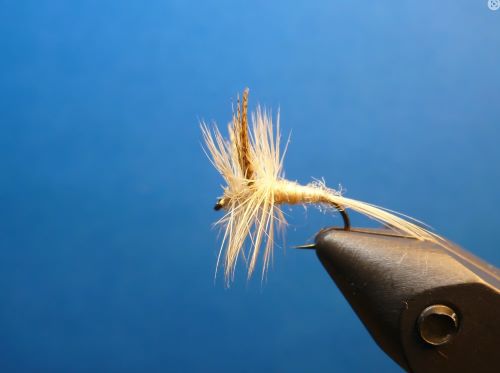Mayflies are common inhabitants of many productive stillwaters. During spring, mayfly emergences typically follow the heavy hatches of chironomids. May is often a good month to find mayflies hatching, but the timing of their emergence is based on water temperature. This year’s early ice-off saw good hatches as early as mid-April on some low-elevation lakes.

The majority of mayflies we see in small Interior stillwaters belong to the family Baetidae and genus Callibaetis, commonly known as speckle-wing mayflies. Preferred habitat for the nymphs is the submergent (partly submerged) and benthic (bottom) vegetation covering the shallow-water or shoal zones of a lake. The most abundant populations are found in clear lakes with abundant marl, and chara-lined shoals. While marl looks like white or yellowish-white sand covering the lake bottom, it is actually calcium-laden particulate that has formed a shallow layer covering the shoals. Chara (or stonewort) is a calcium-encrusted green alga prominent in alkaline stillwaters throughout North America.
Mayfly life cycle
Most mayflies have a one-year life cycle. As the name suggests, their most intense emergences to the adult stages typically occur in the spring to early summer. Trout feed heavily on the short but intense emergent swims of the mature mayfly nymph. The nymphs swim en masse along a shallow angle to the lake’s surface to emerge into the sub-adult (or dun) stage. Mayfly nymph-fishing is typically done on the shoal, or in water depths less than about eight metres (25 feet). Trout also feed on the partially emerged nymphs as they struggle to break through the surface film. Newly emerged duns are again easy food items for foraging trout. Splashy surface riseforms are the telltale sign that trout are picking off the adults as they sit on the surface film.

Trout also feed on immature or juvenile mayfly nymphs that live amongst the rooted vegetation and chara masses covering the lake’s shoal areas. Immature mayfly nymphs show up most commonly in the diet of trout during the fall.
Mayfly fly patterns and retrieval
Imitating the various life stages of mayflies, and their movement through or on the water, is best accomplished with floating and intermediate-sinking fly lines. A floating line with varied leader lengths will let you cover any depth, from less than a metre (a few feet) to over six metres (20 feet). Intermediate- and slow-sinking fly lines are also effective in imitating the shallow angle of ascent of mature nymphs.
Compared to the emergences of chironomids or damselflies, the Callibaetis emergence in many productive stillwaters is relatively short. Often the majority of mayflies in a particular lake will emerge within about a 14-day period; beyond that, there will only be very light hatches. While trout aggressively eat the newly emerged duns that are sitting on the water, there will almost always be more fish gorging on the deeper-swimming nymphs, since it’s always safer to feed closer to the lake bottom than higher in the water column.

Effective nymphal patterns include pheasant tail nymphs, bead head pheasant tail nymphs, Gold Bead Hare’s Ear, and Skip Nymphs. Adult patterns that work include the Parachute Adams, Adams, Lady McConnell, slender Humpies, and deer hair emerger mayflies.
Author: Brian Chan, Fishing Advisor, Freshwater Fisheries Society of BC
Images: Brian Chan, Dusty Waite, Cliff Razzo.
